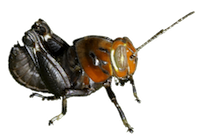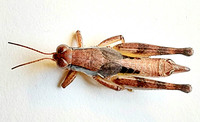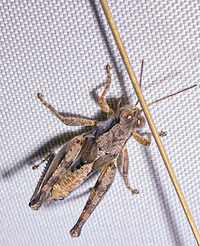Family (Alpha): ACRIDIDAE GRYLLACRIDIDAE GRYLLIDAE GRYLLOTALPIDAE RHAPHIDOPHORIDAE ROMALEIDAE TETRIGIDAE TETTIGONIIDAE TRIDACTYLIDAE
View Acrididae Members:
Metaleptea brevicornis Schistocerca alutacea Schistocerca americana Schistocerca damnifica Schistocerca lineata Schistocerca obscura Schistocerca rubiginosa Schistocerca unidentified species Amblytropidia mysteca Syrbula admirabilis Chloealtis conspersa Eritettix simplex Pseudochorthippus curtipennis Mermiria unidentified species Mermiria bivittata Mermiria intertexta Mermiria picta Dichromorpha elegans Dichromorpha viridis Orphulella pelidna Orphulella speciosa Leptysma marginicollis Stenacris vitreipennis Campylacantha olivacea Paratylotropidia beutenmuelleri Eotettix pusillus Hesperotettix viridis Hesperotettix viridis brevipennis Melanoplus unidentified species Melanoplus viridipes group unidentified species Melanoplus acrophilus Melanoplus angustipennis Melanoplus attenuatus Melanoplus bispinosus Melanoplus bivittatus Melanoplus carnegiei Melanoplus celatus Melanoplus cherokee Melanoplus confusus Melanoplus coreyi Melanoplus deceptus Melanoplus decoratus Melanoplus decorus Melanoplus devius Melanoplus differentialis Melanoplus divergens Melanoplus eurycercus Melanoplus femurrubrum Melanoplus hubbelli Melanoplus impudicus Melanoplus keeleri Melanoplus keeleri keeleri Melanoplus keeleri luridus Melanoplus mirus Melanoplus n. sp. 35 Melanoplus n. sp. 6 Melanoplus nigrescens Melanoplus nossi Melanoplus nubilus Melanoplus pachycercus Melanoplus propinquus Melanoplus punctulatus Melanoplus punctulatus arboreus Melanoplus punctulatus punctulatus Melanoplus sanguinipes Melanoplus sanguinipes atlanis Melanoplus sanguinipes defectus Melanoplus scudderi Melanoplus serrulatus Melanoplus similis Melanoplus strumosus Melanoplus sylvestris Melanoplus tribulus Melanoplus walshii Paroxya atlantica Paroxya clavuligera Booneacris variegata Dendrotettix australis Dendrotettix zimmermanni Stethophyma celatum Arphia unidentified species Arphia granulata Arphia sulphurea Arphia xanthoptera Chortophaga australior Chortophaga viridifasciata Chortophaga unidentified species Encoptolophus sordidus Hippiscus ocelote Pardalophora apiculata Pardalophora phoenicoptera Psinidia fenestralis Trachyrhachys kiowa Dissosteira carolina Spharagemon bolli Spharagemon cristatum Spharagemon marmoratum pictum Trimerotropis maritima Trimerotropis saxatilis NC Records
Melanoplus mirus Rehn & Hebard, 1916 - Weldon Melanoplus
Taxonomy
Family: Acrididae
Subfamily: MelanoplinaeTribe: MelanopliniComments: Melanoplus is our largest genus of Orthopterans, with over 350 species occurring in North America (Cigliano et al., 2017). 38 species have been recorded in North Carolina. Mirus was placed in the Puer Species Group by Rehn and Hebard (1916), Blatchley (1920), and Hubbell (1932), which in North Carolina also included strumosus. However, OSF now defines the Puer Group as excluding both of these species.Species Status: The type locality, and for a long time the only known location for this species, is Weldon, North Carolina (Rehn and Hebard, 1916).
Identification
Field Guide Descriptions: Online Photographs: OSF provides diagrams of the male reproductive structures apparently based on the NCSU specimen, Google Images ,
iNaturalist , GBIF Technical Description, Adults/Nymphs: Rehn and Hebard (1916); Blatchley (1920); Hubbell (1932) Comments: A small, short-winged (flightless) grasshopper. The head, body, and legs are mainly reddish- to yellowish-brown, with a shining black stripe running along the sides of the thorax and on the first couple of segments of the abdomen. The hind tibiae are yellowish or possibly glaucous, but definitely not reddish.Total Length [body plus wings; excludes ovipositor]: 15.5-16.2 mm, males; 18.8-20 mm, females (Rehn and Hebard, 1916)Structural Features: The tegmina are shorter than the pronotum, sub-truncate, and non-overlapping dorsally. The external reproductive structures of the male easily separate this species from all other short-winged species of Melanoplus. The sub-genital plate possess an especially prolonged and conical tubercle; the furculae are absent; and the cerci are broad at the base, narrowly constricted at the middle, broadly widening again but narrowing to a point at the apex.Nymphal Stages and Development: Not described
Distribution in North Carolina
County Map: Clicking on a county returns the records for the species in that county.
Adult Dates: Click on graph to enlarge
Habitats and Life History
Habitats: Described as "scattered woods of low pines and oaks, with a fairly typical psammophilic [sand-loving] undergrowth of huckleberry and other low bushes and plants" (Rehn and Hebard, 1916). The habitat where the Surry County specimen was obtained is undescribed by possibly also consisted of dry woodlands composed of pines, oaks, and heaths but probably had rocky rather than sandy soils. The site where this species was recently collected in Bladen County consists of a xeric sand rim bordering a large Carolina bay lake. Sites where this species has now been collected in South Carolina are also associated with sandhills habitats, some of which are described as xeric (GBIF). Diet: UnknownObservation Methods: Probably best observed by flushing them during the day by walking through their habitats. Rehn and Hebard (1916) described mirus as not jumping strongly but instead more likely to try to hide, making them easy to catchAbundance/Frequency: Known globally only from a handful of specimens from just three sites; the frequency of occurrence and actual abundance are consequently impossible to estimate. Described as scarce at the type locality by Rehn and Hebard (1916)Adult Phenology: Based on just the few specimens that have been observed, this species seems to be present as adults in June and July
Status in North Carolina
Natural Heritage Program Status: SRNatural Heritage Program Ranks: GH S1?State Protection: Considered Significantly Rare by the Natural Heritage Program. That designation, however, does not confer any legal protection and insects in general are not covered by the state's Endangered and Threatened Wildlife Act. Permits are required to collect this species on state park lands, game lands, and other protected natural areas.Comments: This species is one of the rarest and least known grasshoppers in North America. Six specimens were collected by Rehn and Hebard (1916) at the type locality and apparently just a single specimen was collected in 1931 by B.B. Fulton. Specimens collected in 2009 by JoVonn Hill were the first collected in 78 years and extended the range significantly to the southern Coastal Plain of North Carolina. It has also now been collected in South Carolina at the Sandhills National Wildlife Refuge. Habitats at these recently recorded locations for this species all appear to be dry to xeric stands of pine/oak woodlands. These habitats were probably once common in the vicinity of the type locality near Weldon but have now been largely been converted to broad expanses of cultivated fields or vast tracts of pine plantations.
Image Gallery for Melanoplus mirus - Weldon Melanoplus Recorded by: Larry Chen, Sarah Toner, Joye Zhou, and Jeff Niznik Recorded by: Larry Chen, Sarah Toner, Joye Zhou, and Jeff Niznik Recorded by: Larry Chen, Sarah Toner, Joye Zhou, and Jeff Niznik Recorded by: Mark Basinger Recorded by: Mark Basinger Recorded by: B.B. Fulton

 »
»



 »
»

